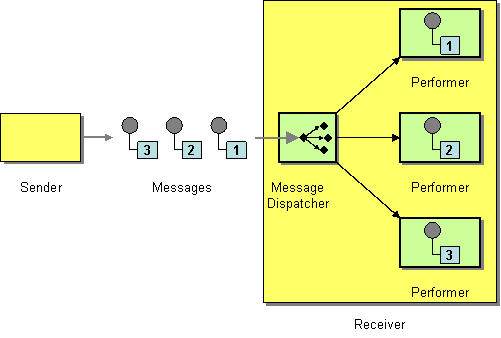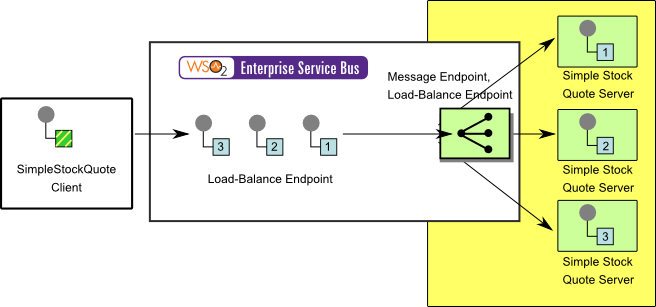Enterprise Integration Patterns
Message Dispatcher
This section explains, through an example scenario, how the Message Dispatcher EIP can be implemented using WSO2 ESB. The following topics are covered:
Introduction to Message Dispatcher
The Message Dispatcher EIP consumes messages from a single channel and distributes them among performers. It allows multiple consumers on a single channel to coordinate their message processing. For more information, refer to http://www.eaipatterns.com/MessageDispatcher.html.
Figure 1: Message Dispatcher EIP
Example scenario
This example scenario demonstrates how to distribute messages among performers using the weighted load balance mediator. We have several Axis2 server instances, each considered to be a performer.
The diagram below depicts how to simulate the example scenario using the WSO2 ESB.
Figure 2: Example Scenario of the Message Dispatcher EIP
Before digging into implementation details, let's take a look at the relationship between the example scenario and the Message Dispatcher EIP by comparing their core components.
| Message Dispatcher EIP (Figure 1) | Message Dispatcher Example Scenario (Figure 2) |
|---|---|
| Sender | Simple Stock Quote Client |
| Messages | Simple Stock Quote Requests |
| Message Dispatcher | Message Endpoint, Load-Balance Endpoint |
| Performers | Simple Stock Quote Server Instances |
Environment setup
- Download and install WSO2 ESB from http://wso2.com/products/enterprise-service-bus. For a list of prerequisites and step-by-step installation instructions, refer to Getting Started in the WSO2 ESB documentation.
- Start three sample Axis2 server instances on ports 9000, 9001, and 9002. For instructions, refer to the section Setting Up the ESB Samples - Starting the Axis2 server in the WSO2 ESB documentation.
ESB configuration
Start the ESB server and log into its management console UI (https://localhost:9443/carbon). In the management console, navigate to the Main menu and click Source View in the Service Bus section. Next, copy and paste the following configuration, which helps you explore the example scenario, to the source view.
<definitions xmlns="http://ws.apache.org/ns/synapse">
<sequence name="fault">
<log level="full">
<property name="MESSAGE" value="Executing default "fault" sequence"/>
<property name="ERROR_CODE" expression="get-property('ERROR_CODE')"/>
<property name="ERROR_MESSAGE" expression="get-property('ERROR_MESSAGE')"/>
</log>
<drop/>
</sequence>
<sequence name="main">
<in>
<send>
<endpoint>
<loadbalance algorithm="org.apache.synapse.endpoints.algorithms.WeightedRoundRobin">
<endpoint>
<address uri="http://localhost:9000/services/SimpleStockQuoteService/"/>
<property name="loadbalance.weight" value="1"/>
</endpoint>
<endpoint>
<address uri="http://localhost:9001/services/SimpleStockQuoteService/"/>
<property name="loadbalance.weight" value="2"/>
</endpoint>
<endpoint>
<address uri="http://localhost:9002/services/SimpleStockQuoteService/"/>
<property name="loadbalance.weight" value="3"/>
</endpoint>
</loadbalance>
</endpoint>
</send>
</in>
<out>
<send/>
</out>
</sequence>
</definitions>
Simulating the sample scenario
Repeatedly send several requests to the ESB using the Stock Quote client as follows:
ant stockquote -Dtrpurl=http://localhost:8280/ -Dsymbol=foo
Following is the request sent by the Stock Quote client in this example:
<soapenv:Envelope xmlns:soapenv="http://www.w3.org/2003/05/soap-envelope" xmlns:ser="http://services.samples" xmlns:xsd="http://services.samples/xsd">
<soapenv:Header />
<soapenv:Body>
<ser:getQuote>
<ser:request>
<ser:symbol>foo</ser:symbol>
</ser:request>
</ser:getQuote>
</soapenv:Body>
</soapenv:Envelope>
Note in each Axis2 server console that the requests are distributed among several servers in a weighted manner. Servers running on port 9000, 9001, and 9002 receive the request in that order until the process starts over again in a round-robin manner.
How the implementation works
Let's investigate the elements of the ESB configuration in detail. The line numbers below refer to the ESB configuration shown above.
- endpoint [line 13 in ESB config] - Defines the endpoint where the request should be sent.
- loadbalance [line 14 in ESB config] - Defines a set of endpoints where incoming requests are distributed using a particular algorithm. In this example, the algorithm distributes messages in a weighted round-robin manner.

